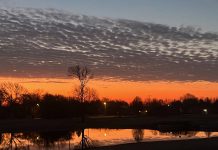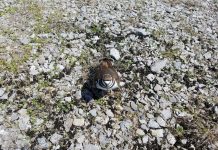Through two centuries of work, artists have helped the story of Indiana come alive.
Delicate drawings show pioneer towns carved out of the Indiana wilderness. Civil War soldiers take cover behind ice-covered rocks in a powerful oil painting.
Natural beauty, from the beaches of Lake Michigan to the hills of Brown County to the Ohio River valley, reveal what drew settlers to the area in the first place. Indiana’s racial diversity, industrial heritage and changing future is told using bright oil paints, limestone blocks and bronze.
To celebrate the state’s bicentennial this year, the Indiana State Museum is taking visitors on a journey through 200 years of art history. The exhibition, including a mixed media collage by longtime artist Gretchen Sigmund of Columbus, explores the role art had in shaping Indiana, from before it was founded through its agrarian roots to industrial and modern society.
From Native American artwork to masterpieces by Brown County impressionist T.C. Steele, known for his Indiana landscapes, museum officials hope that the breadth of the exhibition hammers home just how vital Indiana’s artistic contributions have been.
“The art made reflects the time it was created — it reflects the technology and the knowledge and the opportunity that is available to do it,” said Mark Ruschman, chief fine arts curator for the Indiana State Museum. “What I want everybody to take away from the exhibition is a better understanding of what things were like and how they got to where they are today.”
“200 Years of Indiana Art: A Cultural Legacy” was designed as a walkable art history book, using 173 pieces to take visitors from the earliest examples of artwork in the state through its various inceptions and styles.
Sigmund’s four-foot by four-foot 1991 work, “Dropping a Line,” includes a collection of weathered, overlapping postcards, many with smudged-out handwriting and details, mixed in with paint. A small line actually hangs off the piece. The 80-year-old Sigmund, a friend of Ruschman’s, has long been fascinated by the slow disappearance of handwriting in a technological world.
“It’s almost gone,” she said, adding that she inherited much of her mother’s international postcard collection. “And that’s a shame.”
Her artistic exuberance is so well-known that she has used her craft in recent years to help pull people from depression. But her work has earned serious attention from peers, too. One of her paintings became part of the state museum’s permanent collection about a year ago. This marks her first appearance in a museum exhibition.
“It’s a real honor to be in this,” Sigmund said, citing works from artists such as Robert Indiana and William T. Wiley. “The opening was an amazing event.”
The exhibition includes all kinds of media.
“When putting this show together, the criteria was fairly broad and I had a lot of latitude to work with,” Ruschman said. “I wanted the work to be of high quality. I wanted it to represent as much of the state as possible. And I wanted people to have an understanding of where we’ve been and how far we’ve come.”
The exhibition is centered in two main galleries on the museum’s third floor. As soon as people walk into the main gallery, they are presented with minutely detailed drawings and rough paintings, showing settlers establishing the first communities in Indiana.
Often, these “pioneer artists” traveled from town to town.
“They were itinerant artists, looking for work,” Ruschman said. “There weren’t large populations of people living in one place, so artists looking for business had to travel.”
Many of the pieces, particularly showing the state’s early history, are more documentary than fine artwork, Ruschman said.
“These were not tremendous works of art. But they speak very much to the point that artists were doing these types of things. It wasn’t about sweeping landscapes or famous people’s portraits,” he said.
The narrative of the show moves through important periods in Indiana art, from the rise of noted groups such as the Hoosier Group and Brown County Artists Colony, to the more industrial scenes in the art, to the avant garde use of glass, ceramic and technology.
To cover such broad ground, Ruschman worked with other museums, historical institutions and private collectors to amass a representative group of artwork.
“I wanted this show to represent as much of the state as possible, being that it’s our bicentennial,” he said. “I wanted others to feel like they had a stake in the show.”
The exhibition spills out throughout the rest of the museum, as well. Five public art installations have been included to showcase the importance of large-scale modern art in the community, Ruschman said.
The estate of George Rickey, a South Bend native and internationally famous sculptor, contributed a pair of his kinetic geometric metal pieces.
A special gallery was created for a work by Indianapolis-based artist Anila Quayyum Agha. Using a large, laser-cut cube of patterned wood, a light bulb and six white walls, Agha projects the geometric patterns of the Spanish fortress the Alhambra onto every surface.
As soon as people walk into the museum, they pass by a tidal wave of used compact discs put together in a sculpture called “Event Horizon,” by artist Leticia Bajuyo.
“We wanted to immediately make an impression with people,” Ruschman said. “As people come in, it used to be they’d just walk in and make their way to the ticket desk. Here, we’ve taken a wall that was otherwise overlooked and given it to the artist.”
Another gallery features a selection of pieces from current Herron School of Art and Design students, spotlighting the next generation of Indiana’s great artists, Ruschman said.
“It includes a wide variety of works, paintings, sculpture, photography, to show what students are doing now — what’s important to them, subject matter, commentary,” he said. The rest of the exhibition shows what has come before and what’s out now. This is looking at the future.”
Republic staff writer Brian Blair contributed to this report.
[sc:pullout-title pullout-title=”If you go” ][sc:pullout-text-begin]
“200 Years of Indiana Art: A Cultural Legacy”
What: The story of Indiana told through its artwork, from pioneer artists to contemporary works.
Where: Indiana State Museum, 650 W. Washington St., Indianapolis
Pieces: 173
On display: Through Oct. 2
Hours: 10 a.m. to 5 p.m. Monday through Saturday; 11 a.m. to 5 p.m. Sunday
Admission: $13 for adults, $12 for seniors age 60 and up, $9.75 for Indiana college students, $8.50 for children ages 3 to 17, free for kids 2 and under.
Information: indianamuseum.org
[sc:pullout-text-end]




